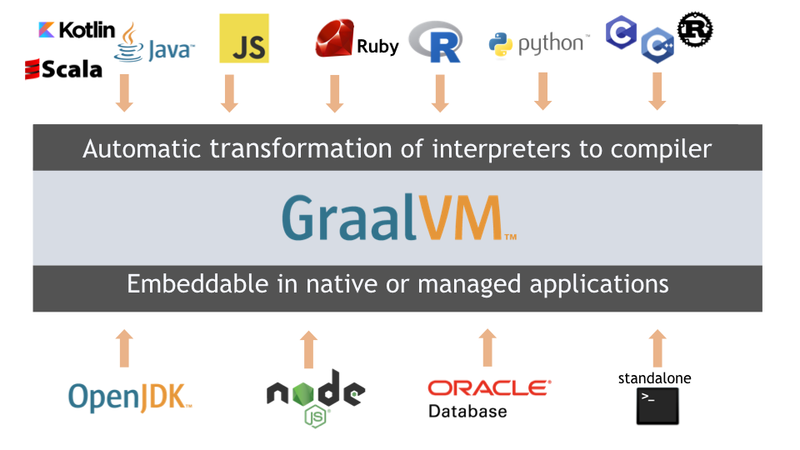
GraalVM, the future of microservices applications in Java
This article is the second in a series discussing the concepts introduced in GraalVM and how they are game-changing for using Java as a programming language in microservice architectures.
GraalVM, a new generation of virtual machine

What is that ?
- GraalVM is a Virtual Machine (VM), Open Source, resulting from a research project at Oracle Labs.
It is maintained by a community of major Internet players (Oracle, Amazon, Twitter, RedHat in particular with Quarkus, VMWare for the integration of its Spring framework, …).
It is a new generation of VM, polyglot, that is to say that it supports many languages, even those which do not generate bytecode. Eventually, it could replace the current VM HotSpot.
- More details at https://www.graalvm.org/
In a few words
The GraalVM VM is coupled to a new compiler, Graal, written entirely in Java (which allows cyclic compilation):
- It aims to replace the
C2compiler used for the JIT of the HotSpot VM and which has reached the end of its life because it is too complex to upgrade (mix of assembler, C, Java ) - The Grail compiler can also do
AOTcompilation (Ahead-Of-Time, in advance) also called advance compilation.
The architecture of GraalVM

1. The Grail compiler
- It compiles in Bytecode languages for JVM.
- Integrated into the JVM, it is able to do JIT compilation.
- It can also do AOT compilation.
2. The Truffle framework
- It allows to describe, in the form of an Abstract Syntax Tree (AST or Syntax Tree), the grammar of languages unknown to the JVM.
- The Graal compiler, using the Truffle modules of each language, is able to interact with them.
- The Polyglot API, written in Java, allows messages to be passed from Java to other languages and to interact with them.
Example of Truffle modules
Graal.jsdefines the AST of JavaScript.Sulongimplements the AST of the LLVM bitcode (C, C++, Rust, Objective-C, Fortran, Mono, …)- Other modules being implemented:
WebAssembly(for web applications),CUDA(for NVidia graphics cards), …
3. The Virtual Machine
Two JVMs can be integrated into GraalVM as a Virtual Machine:
- By default, it is the JVM HotSpot which executes the bytecode of Java programs. But it is the Graal compiler which intervenes in the JIT compilation.
- You can also install the SubstrateVM virtual machine, included in the nativeimage module. It is this minimalist VM that offers the AOT compilation.
4. Runtimes
- They allow you to run languages other than those supported by the JVMs (the HotSpot JVM like the SubstrateVM).
- The
node.js(ECMAScript compliant) andllvmruntimes are part of the standard installation. - The other runtimes must be explicitly installed: the Python 3.7 interpreter, that of Ruby 2.6.5 or even of GNU R 3.6.1.
The components of GraalVM:
- Core components:
- the JVM GraalVM,
- the Grail compiler,
- an LLVM runtime,
- a JavaScript runtime that supports Node.js
- Optional runtimes:
- Native Image which integrates the ahead-of-time (AOT) compiler
- LLVM toolchain
- Python interpreter
- Ruby interpreter
- R interpreter
- WebAssembly interpreter (Wasm)
So what ?
We are now entitled to wonder, how this is a game-changer for Java and microservices.
Of course, we had to go through this theoretical presentation but already, we can understand the full potential of such an overhaul:
- A new, more efficient compiler,
- The ability to compile your application directly in native code,
- The ability to integrate multiple languages into its Java application, …
It remains to be seen in practice the result. This is what we will do in the next article.
Cheers …




